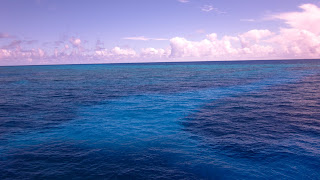Leigh and I love diving, partly for the travel, partly for the adventure, but also because of our mutual interest in biology.
The world's total surface area of coral reefs amounts to about half the size of France. However, about 25% of the ocean's biodiversity is found on coral reefs.
This diversity comes despite nutrient-poor tropical waters. Charles Darwin called coral reefs "oases in the desert of the ocean." The same crystal-clear water we love on vacation also means there are few nutrients in the water column.
Coral polyps form the building blocks of reefs by creating a calcium carbonate (limestone) shell. They overcome the nutrient poor tropical waters by relying on zooxanthellae, a photosynthetic algae that lives within the polyp. The zooxanthellae produce up to 90% of the energy required by the coral polyp.
Coral polyps are demanding of certain environmental conditions. They must have constant temperatures, pH, salinity, and sunlight to support them.



No comments:
Post a Comment